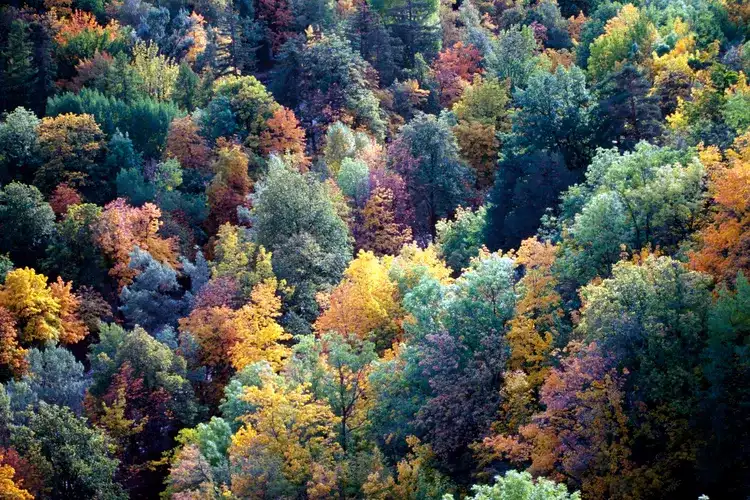Temperate forests represent one of Earth’s most dynamic and diverse land biomes. Known for their four distinct seasons and abundance of broad-leaved trees, these forests are vital ecosystems supporting a wide array of plant and animal life. Their ability to regenerate through seasonal cycles, along with their role in carbon storage and biodiversity, makes them crucial in the context of climate and environmental balance.
Understanding the Climate of Temperate Forests
One of the defining features of temperate forests is their highly variable climate, shaped by the changing seasons. Summers can be warm to hot, with temperatures reaching up to 86°F (30°C), while winters may plunge to frigid lows of -22°F (-30°C). Annual precipitation typically ranges from 20 to 60 inches and may fall as rain, snow, or a combination of both, providing ample moisture for rich vegetation and soil formation.
Seasonal Shifts and Plant Responses
As daylight shortens and temperatures drop in autumn, photosynthesis slows and deciduous trees shed their leaves. This leaf loss is a survival strategy, reducing water loss during the dry, cold months. New growth resumes in spring when the environment becomes more favorable, kicking off a fresh cycle of lush development.
Where Temperate Forests Thrive
Due to their climate requirements, temperate forests are mostly found in mid-latitude regions between 25 and 50 degrees in both hemispheres. They stretch across three main continents, creating vast green belts of life.
- Eastern United States: From the Appalachian Mountains to the Midwest, these forests are iconic for their colorful autumns.
- Central and Western Europe: Including France, Germany, and parts of the U.K., where oak, beech, and birch are prevalent.
- Eastern Asia: Especially China, Japan, and Korea, where ancient woodlands are home to rare and endemic species.
Vegetation Layers and Plant Diversity
Temperate forests are layered ecosystems with rich biodiversity at every level, from the forest floor to the canopy. Deep, nutrient-rich soil allows for a variety of plant types, and each layer plays a distinct role in the health of the ecosystem.
Vegetation Tiers
- Canopy tier: Dominated by tall trees like maple, birch, oak, walnut, and hickory.
- Understory tier: Smaller trees such as dogwoods, redbuds, and shadbush fill this layer.
- Shrub tier: Includes mountain laurel, azaleas, and huckleberries.
- Herbaceous layer: Wild sarsaparilla, Indian cucumber, and blue bead lily thrive close to the ground.
- Ground layer: Home to mosses and lichens, essential for decomposing organic matter and enriching the soil.
Mosses vs. Lichens
While mosses are small nonvascular plants that retain moisture and prevent erosion, lichens are symbiotic organisms composed of fungi and algae or cyanobacteria. Together, they aid in breaking down organic debris and play a vital role in nutrient cycling.
Wildlife in Temperate Forests
Temperate forests host a broad spectrum of animal species, many of which have adapted to survive both the warm summers and the harsh winters. From massive mammals to tiny insects, these forests are teeming with life.
- Mammals: Bears, deer, foxes, coyotes, bobcats, moose, raccoons, and skunks
- Birds: Hummingbirds, eagles, and owls
- Reptiles and amphibians: Snakes, salamanders, and frogs
- Invertebrates: Insects, spiders, and worms that form the foundation of the food chain
Surviving the Winter
Wildlife employs a variety of strategies to endure seasonal scarcity and cold. Some, like bears, hibernate. Others, such as squirrels and foxes, store food or burrow underground. Migratory birds simply escape the winter by flying to warmer climates. Camouflage also plays a critical role—many animals have adapted to blend in with fallen leaves or snow to avoid predators or sneak up on prey.
Temperate Forests Among the World’s Biomes
Temperate forests are just one part of Earth’s rich biome mosaic. Understanding how they compare with other land biomes helps paint a fuller picture of the planet’s ecological diversity.
Other Major Terrestrial Biomes
- Deserts: Dry regions that may be hot (Sahara) or cold (Antarctica).
- Tundras: Treeless areas with permafrost and minimal precipitation.
- Tropical rainforests: Found near the equator, warm and humid year-round.
- Taigas (boreal forests): Dominated by conifers, colder than temperate forests.
- Grasslands: Include temperate grasslands and savannas, featuring wide open spaces and seasonal rainfall.
- Chaparrals: Characterized by dry summers and wet winters, with dense shrubs and small trees.
FAQs About Temperate Forests
- Where are temperate forests located?
Mostly in North America, Europe, and Asia, at mid-latitudes between 25 and 50 degrees. - What do they look like?
These forests are marked by thick canopies of deciduous trees that change appearance dramatically with the seasons—from lush green in summer to colorful in fall and bare in winter. - How is climate change affecting them?
Rising temperatures and shifting precipitation patterns have led to more wildfires, pest outbreaks, and changes in species distribution. These stressors can reduce forest productivity and biodiversity. - How many land biomes exist?
While classifications vary, seven primary land biomes are commonly recognized: temperate forests, tropical rainforests, tundras, deserts, taigas, grasslands, and savannas.
Temperate forests are not only visually stunning through the seasons, but they also provide critical services to the environment and the creatures humans included that rely on them. Protecting and understanding these biomes is key to sustaining biodiversity and combating climate change.





